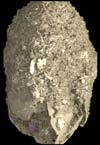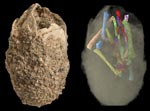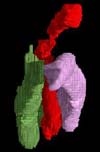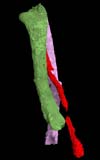|
|
This specimen was originally described as a neoceratopsian dinosaur egg by Balanoff et al., 2008. However, further examination of the high-resolution X-ray CT data has resulted in a reidentification of the specimen as an enantiornithine bird in a paper entitled Reidentification of Avian Embryonic Remains from the Cretaceous of Mongolia, by D.J. Varricchio, A.M. Balanoff and M.A. Norell (2015, PLoS ONE 10(6): e0128458). The abstract is as follows:
Embryonic remains within a small (4.75 by 2.23 cm) egg from the Late Cretaceous, Mongolia are here re-described. High-resolution X-ray computed tomography (HRCT) was used to digitally prepare and describe the enclosed embryonic bones. The egg, IGM (Mongolian Institute for Geology, Ulaanbaatar) 100/2010, with a three-part shell microstructure, was originally assigned to Neoceratopsia implying extensive homoplasy among eggshell characters across Dinosauria. Re-examination finds the forelimb significantly longer than the hindlimbs, proportions suggesting an avian identification. Additional, postcranial apomorphies (strut-like coracoid, cranially located humeral condyles, olecranon fossa, slender radius relative to the ulna, trochanteric crest on the femur, and ulna longer than the humerus) identify the embryo as avian. Presence of a dorsal coracoid fossa and a craniocaudally compressed distal humerus with a strongly angled distal margin support a diagnosis of IGM 100/2010 as an enantiornithine. Re-identification eliminates the implied homoplasy of this tri-laminate eggshell structure, and instead associates enantiornithine birds with eggshell microstructure composed of a mammillary, squamatic, and external zones. Posture of the embryo follows that of other theropods with fore- and hindlimbs folded parallel to the vertebral column and the elbow pointing caudally just dorsal to the knees. The size of the egg and embryo of IGM 100/2010 is similar to the two other Mongolian enantiornithine eggs. Well-ossified skeletons, as in this specimen, characterize all known enantiornithine embryos suggesting precocial hatchlings, comparing closely to late stage embryos of modern precocial birds that are both flight- and run-capable upon hatching. Extensive ossification in enantiornithine embryos may contribute to their relatively abundant representation in the fossil record. Neoceratopsian eggs remain unrecognized in the fossil record.

About the Species
This specimen was made available to the University of Texas High-Resolution X-ray CT Facility for scanning by Dr. Matthew Lewin of the UCSF Medical Center. Funding was provided by Dr. Lewin.

About this Specimen
This specimen was scanned by Matthew Colbert on 3 February 2004 along the 'coronal' (long) axis for a total of 1296 slices. Each 1024 x 1024 pixel slice is 0.036 mm thick, with an interslice spacing of 0.036 mm and a field of reconstruction of 32 mm.

About the
Scan
Literature
Balanoff AM, Rowe T. (In Press) Osteological description of an embryonic skeleton of the extinct elephant bird, Aepyornis (Palaeognathae: Ratitae). Soc Vert Paleontol Memoir 9, J Vert Paleontol.
Bohlin B. (1953) Fossil Reptiles from Mongolia and Kansu. The Sino-Swed Exped, Pub no. 37:1-105
Brown B, Schlaikjer EM. (1940) The structure and relationships of Protoceratops. Ann NY Acad Sci 40:133- 266.
Carpenter K, Alf K. (1994) Global distribution of dinosaur eggs, nests, and babies. In Carpenter K, Hirsch KF, Horner JR (eds.) Dinosaur Eggs and Babies. Cambridge University Press, Cambridge, pp 15-30.
Chinnery B. (2004) Morphometric analysis of evolutionary trends in the ceratopsian postcranial skeleton. J Vert Paleontol 24:591-609.
Dodson P, Forster CA, Sampson SD. (2004) Ceratopsidae. In Weishampel DB, Dodson P, Osmólska H (eds.) The Dinosauria. University of California Press, Berkeley, pp 494-513.
Dong Z-M, Currie PJ. (1993) Protoceratopsian embryos from Inner Mongolia, People's Republic of China. Can J Earth Sci 30:2248-2254.
Emerson SB, Bramble DM. (1993) Scaling, allometry, and skull design. In: Hanken J, Hall BK (eds.) The Skull, Volume 3: Functional and Evolutionary Mechanisms. University of Chicago Press, Chicago, pp 384-416.
Erickson GM, Tumanova TA. (2000) Growth curve of Psittacosaurus mongoliensis Osborn (Ceratopsia: Psittacosauridae) inferred from long bone histology. Zool J Linn Soc—Lond 130:551-566.
Faccio G. (1994) Dinosaurian eggs from the upper Cretaceous of Uruguay. In Carpenter K, Hirsch KF, Horner JR (eds.) Dinosaur Eggs and Babies. Cambridge University Press, Cambridge, pp 47-55.
Gauthier J, Kluge AG, Rowe T. (1988) Amniote phylogeny and the importance of fossils. Cladistics 4:105-209.
Goodwin MB, Clemens WA, Horner JR, Padian K. (2006) The smallest known Triceratops skull: new observations on ceratopsid cranial anatomy and ontogeny. J Vert Paleontol 26:103-112.
Grellet-Tinner G. (2005) The membrana testacea of titanosaurid dinosaur eggs from Auca Mahuevo (Argentina): implications for the exceptional preservation of soft tissue in Lagerstätten. J Vert Paleontol 25:99-106.
Grellet-Tinner G. (2006) Phylogenetic interpretation of eggs and eggshells: implications for oology and Paleognathae phylogeny. Alcheringa 30:130-180.
Grellet-Tinner G, Chiappe L, Bottjer D, Norell M. (2006) Paleobiology of dinosaur eggs and nesting behaviors. Palaeogeogr Palaeocl Palaeoecol 232:294-321.
Grellet-Tinner G, Makovicky PJ. (2006) A possible egg of the theropod Deinonychus antirropus: phylogenetic and biological implications. Can J Earth Sci 43:705-719.
Horner JR, Currie PJ. (1994) Embryonic and neonatal morphology and ontogeny of a new species of Hypacrosaurus (Ornithischia, Lambeosauridae) from Montana and Alberta. In Carpenter K, Hirsch KF, Horner JR (eds.) Dinosaur Eggs and Babies. Cambridge University Press, Cambridge, pp 312-336.
Horner JR, Goodwin MB. (2006) Major cranial changes during Triceratops ontogeny. Proc R Soc B 273:2757- 2761.
Horner JR, de Ricqlés A, Padian K. (2000) Long bone histology of the hadrosaurid dinosaur Maiasaura peeblesorum: growth dynamics and physiology based on an ontogenetic series of skeletal elements. J Vert Paleontol 20:115-129.
Makovicky PJ. (2002) Taxonomic revision and phylogenetic relationships of basal neoceratopsia (Dinosauria: Ornithischia). Ph.D. dissertation, Columbia University, 279 pp.
Makovicky PJ. (2006) Ontogenetic changes in Psittacosaurus: implications for taxonomy and phylogeny. J Vert Paleontol 96(suppl. to 3):94A.
Makovicky PJ, Norell MA. (2006) Yamaceratops dorngobienses, a new primitive ceratopsian (Dinosauria: Ornithischia) from the Cretaceous of Mongolia. Am Mus Novit 3530:1-42.
Maryanska T, Osmólska H. (1975) Protoceratopsidae (Dinosauria) of Asia. Palaeontol Pol 33:133-181.
Mikhailov KE. (1995) Systematic, faunistic and stratigraphic diversity of Cretaceous eggs in Mongolia: comparison with China. In Sun A, Wang Y (eds.) Sixth Symposium on Mesozoic Terrestrial Ecosystems and Biota, Short Papers. China Ocean Press, Beijing, pp 165-168.
Mikhailov KE. (1997) Fossil and recent eggshell in amniotic vertebrates: fine structure, comparative morphology and classification. Spec Pap Palaeontol 56:1-80.
Mikhailov KE, Sabath K, Kurzanov S. (1994) Eggs and nests from the Cretaceous of Mongolia. In Carpenter K, Hirsch KF, Horner JR (eds.) Dinosaur Eggs and Babies. Cambridge University Press, Cambridge, pp 98-102.
Norell MA, Clark JM, Chiappe LM. (2001) An embryonic oviraptorid (Dinosauria: Theropoda) from the Upper Cretaceous of Mongolia. Am Mus Novit 3315:1-17.
Norell MA, Clark JM, Chiappe LM, Dashzeveg DY. (1995) A nesting dinosaur. Nature 378:774-776.
Norman DB, Witmer LM, Weishampel DB. (2004) Basal Ornithischia. In Weishampel DB, Dodson P, Osmólska H (eds.) The Dinosauria. University of California Press, Berkeley, pp 325-334.
Reisz RR, Scott D, Sues H-D, Evans DC, Raath MA. (2005) Embryos of an Early Jurassic prosauropod dinosaur and their evolutionary significance. Science 29:761-764.
Ricklefs RE, Starck JM. (1998) Embryonic growth and development. In Starck JM, Ricklefs RE (eds.) Avian Growth and Development: Evolution within the Altricial-Precocial Spectrum. Oxford University Press, New York, pp 31-58.
Russell, ES. (1916, 1982 reprint). Form and Function: A Contribution to the History of Animal Morphology. University of Chicago Press, Chicago.
Salgado L, Coria RA, Chiappe L. (2005) Osteology of the sauropod embryos from the upper Cretaceous of Patagonia. Acta Palaeontol Pol 50:79-92.
Sato T, Cheng YN, Wu X-C, Zelenitsky DK, Hsiao YF. (2005) A pair of shelled eggs inside a female dinosaur. Science 308:375-376.
Schweitzer MH, Jackson F, Chiappe L, Schmitt JG, Calvo JO, Rubilar DE. (2002) Late Cretaceous avian eggs with embryos from Argentina. J Vert Paleontol 22:191-195.
Sereno PC. (1986) Phylogeny of the bird-hipped dinosaurs (Order Ornithischia). Natl Geogr Res 2:234-256.
Starck JM, Ricklefs RE. (1998) Patterns of development: the altricial-precocial spectrum. In Starck JM, Ricklefs RE (eds.) Avian Growth and Development: Evolution within the Altricial-Precocial Spectrum. Oxford University Press, New York, pp 3-30.
Varricchio DJ, Horner JR, Jackson FD. (2002) Embryos and eggs for the Cretaceous theropod dinosaur Troodon formosus J Vert Paleontol 22:564-576.
Xu X, Makovicky PJ, Wang X, Norell MA, You H. (2002) A ceratopsian dinosaur from China and the early evolution of Ceratopsia. Nature 416:314-317.
You H, Dodson P. (2004) Basal Ceratopsia. In: Weishampel DB, Dodson P, Osmólska H (eds.) The Dinosauria. University of California Press, Berkeley, pp 478-493.

Literature
& Links
 |
Click on the thumbnail to the left for a yaw rotation animation (5.9 mb) of the egg rotating as the matrix fades. |

Additional Imagery
 |
|



 ,
, 








